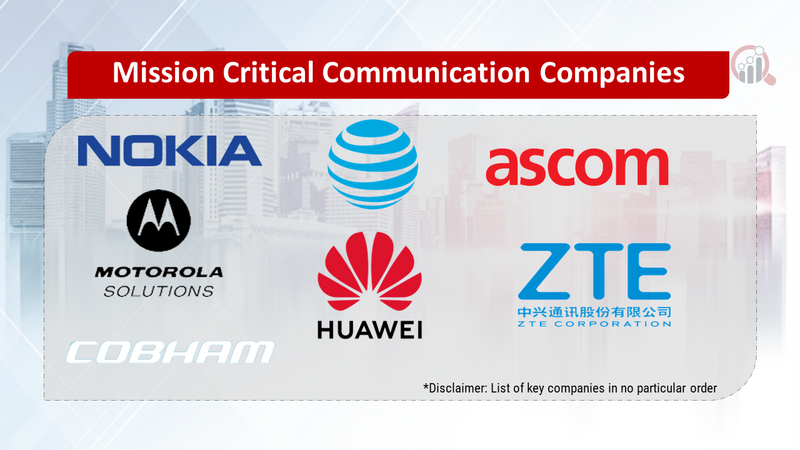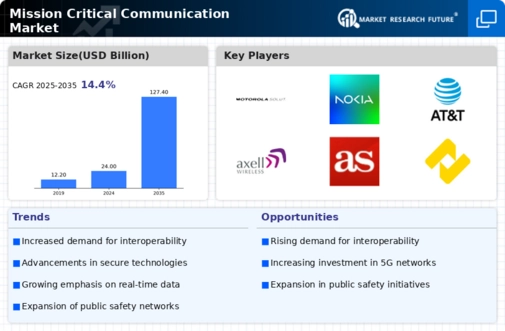Top Industry Leaders in the Mission Critical Communication Market

Competitive Landscape of Mission-Critical Communication Market:
The global mission-critical communication (MCX) market is a dynamic and growing industry, driven by the increasing demand for reliable and secure communication in high-risk environments. This market caters to critical sectors such as public safety, government agencies, transportation, energy and utilities, and mining, requiring seamless and reliable communication infrastructure.
Key players in the MCC market include:
- Motorola Solutions, Inc.
- Nokia
- ZTE Corporation
- Telefonaktiebolaget LM Ericsson
- Huawei Technologies Co. Ltd.
- AT&T Inc.
- L3harris Technologies, Inc.
- Hytera Communications Corp. Ltd.
- Cobham Wireless
- Ascom
- Mentura Group Oy
- Leonardo S.P.A.
- Inmarsat Plc
- Zenitel
- Telstra
Competitive Strategies:
- Technology Leadership: Major players are investing heavily in research and development to stay ahead of the curve with advanced technologies like LTE, 5G, and hybrid networks.
- Partnerships and Acquisitions: Strategic partnerships and acquisitions are key strategies adopted to expand market reach, access new technologies, and strengthen market position.
- Focus on Verticals: Companies are tailoring their solutions to specific industry needs, offering customized solutions for verticals like public safety, transportation, and utilities.
- Service-Oriented Approach: The focus is shifting from solely hardware and software to providing managed services, offering end-to-end solutions and value-added services.
- Cloud-Based Solutions: Cloud-based MCC solutions are gaining traction, offering scalability, cost-efficiency, and faster deployment.
Factors for Market Share Analysis:
- Market share by technology: LMR currently dominates the market, but LTE and 5G technologies are expected to witness significant growth in the future.
- Market share by region: North America and Europe remain the largest markets, but Asia-Pacific is expected to be the fastest-growing region due to rapid urbanization and government investments.
- Market share by end-user industry: Public safety is the largest end-user industry, followed by transportation and utilities. However, other industries like healthcare and mining are expected to show significant growth.
- Market share by company: Motorola Solutions and Nokia are the current market leaders, but competition is intensifying from Chinese players like ZTE and Hytera.
New and Emerging Companies:
- Softil: A software company specializing in interoperability solutions for mission-critical networks.
- Mentura Group Oy: A provider of secure communication solutions for government and military applications.
- Telstra: A telecommunications company offering managed services for mission-critical networks in Australia.
- Inmarsat PLC: A provider of satellite-based communication solutions for maritime and offshore applications.
- Zenitel: A provider of public address and emergency communication systems for buildings and infrastructure.
Current Investment Trends:
- Investments in LTE and 5G technologies: Companies are investing heavily in developing and deploying LTE and 5G solutions for mission-critical applications.
- Cloud-based solutions: Investments are increasing in cloud-based MCC solutions to offer scalability, cost-efficiency, and faster deployment.
- Cybersecurity solutions: Increasing cybersecurity threats are driving investments in secure communication solutions and network management tools.
- Interoperability solutions: Investments are increasing in interoperability solutions that allow different technologies and networks to communicate seamlessly.
- Vertical-specific solutions: Companies are investing in developing customized solutions for specific industries to cater to specific needs and requirements.
September, 2023
In order to keep enterprise teams and public safety personnel safe, connected, and informed over private wireless networks in risky and industrial locations like ports, mines, chemical facilities, and offshore oil platforms, Nokia announced a variety of industrial 5G devices in 2023. New ruggedized 5G handhelds, a new industrial device consumption model, and improvements to applications for workers and devices are all being introduced by the corporation.
With the release of the PT590 mission-critical portable TETRA radio in 2023, Hytera Communications, a top provider of professional communications technologies and solutions, expanded its line of TETRA radios. This radio is made to ensure that frontline workers can always respond and take action by offering excellent coverage, superior audio quality, and increased productivity and safety features.
An international critical broadband service based on Meep's Push to Talk Over Cellular networks (PTToC) communication solution, Synch, and Entropia's mission-critical TETRA control room management platform, ComBus, will be developed further through a long-term strategic partnership between Meep Ltd., an Elbit Systems subsidiary, and Entropia in 2023.









